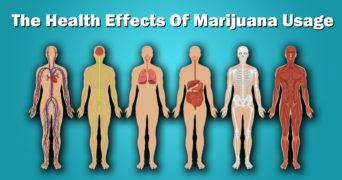As the conversation surrounding marijuana evolves from taboo to acceptance, a deeper understanding of its effects is essential for informed decision-making. While the plant is often celebrated for its potential therapeutic benefits, it’s equally important to consider the other side of the coin. What are the side effects of marijuana? This question looms large for both medicinal and recreational users alike. In this exploration, we’ll unravel the complexities of marijuana’s impact on the body and mind, shedding light on both the well-known and lesser-discussed side effects. Join us as we navigate the nuanced landscape of cannabis, empowering you to make choices that resonate with your health and lifestyle.
Table of Contents
- Understanding the Spectrum of Marijuana Side Effects
- The Impact on Mental Health and Cognitive Function
- Navigating Physical Reactions: What Users Should Know
- Mitigating Risks: Tips for Responsible Use and Consumption
- Q&A
- The Way Forward
Understanding the Spectrum of Marijuana Side Effects
Marijuana, often perceived as a natural remedy, can involve a range of side effects that vary widely among individuals. Some users may experience short-term effects such as increased heart rate and dry mouth, which can lead to minor discomfort but are generally considered manageable. On the other hand, those predisposed to anxiety may find that marijuana exacerbates their symptoms, resulting in feelings of panic or paranoia. Understanding these effects is essential for responsible use, particularly as it’s becoming more normalized in various social contexts.
For long-term users or those consuming marijuana in higher doses, the side effects can shift toward more serious issues. Regular use has the potential to lead to cognitive impairments, such as memory loss and reduced attention span, especially in adolescents. Additionally, some users may develop what is known as Cannabis Use Disorder, which affects motivation and daily functioning. The table below summarizes some common side effects associated with marijuana use:
| Short-Term Effects | Long-Term Effects |
|---|---|
| Increased heart rate | Cognitive impairments |
| Dry mouth | Cannabis Use Disorder |
| Altered senses | Respiratory issues |
| Anxiety/paranoia | Memory loss |
The Impact on Mental Health and Cognitive Function
The relationship between marijuana use and mental health is complex, with research indicating both potential benefits and risks. Regular consumption may lead to issues such as anxiety, depression, and even increased instances of psychosis, particularly in individuals predisposed to mental health disorders. The psychoactive compound THC can alter brain chemistry, sometimes exacerbating existing conditions or triggering new ones. It’s essential to recognize that the effects can vary significantly from person to person, influenced by factors like dosage, frequency of use, and individual biology.
Furthermore, cognitive function can also be impacted by marijuana use. Short-term effects may include impaired memory, decreased attention span, and delayed reaction times. Over time, prolonged usage may contribute to long-lasting cognitive deficits. Below is a brief overview of some cognitive and psychological effects associated with marijuana:
| Effect | Description |
|---|---|
| Memory Impairment | Difficulty in recalling information and forming new memories. |
| Attention Deficits | Struggles to focus on tasks and filter out distractions. |
| Coordination Problems | Increased risk of accidents due to impaired motor skills. |
| Psychotic Symptoms | In some cases, users may experience hallucinations or delusions. |
Navigating Physical Reactions: What Users Should Know
Understanding how marijuana affects the body is crucial for users, especially given its diverse range of physical reactions. While some effects may be sought after for therapeutic or recreational purposes, others can be unexpectedly potent. Users often report a spectrum of physical sensations, which can include relaxation, increased appetite, and drowsiness, but it’s essential to recognize potential adverse reactions as well. An individual’s experience can vary significantly based on factors such as dosage, method of consumption, and personal physiology.
Common physical side effects can encompass:
- Dizziness: Some may experience lightheadedness, particularly with high doses.
- Dry Mouth: Often referred to as “cottonmouth,” this is a well-known response to cannabis.
- Rapid Heart Rate: Users might notice an increase in heart rate, which can be alarming for some.
- Nausea: While marijuana is used to alleviate nausea in some cases, it can paradoxically cause it in others.
It is essential for users to be informed about these physical manifestations and monitor their personal reactions. Keeping track of symptoms can be beneficial for identifying any patterns or intensities that may arise with different strains or methods of consumption. Below is a simple overview:
| Reaction | Commonality | Notes |
|---|---|---|
| Dizziness | Moderate | More common in inexperienced users. |
| Dry Mouth | High | Drink water or keep snacks handy. |
| Rapid Heart Rate | Moderate | Seek calming environments if this occurs. |
| Nausea | Low | Consider dosage adjustments. |
Mitigating Risks: Tips for Responsible Use and Consumption
When considering the responsible use of marijuana, it is crucial to be aware of its potential side effects. Being informed empowers users to make educated choices and promotes a safer experience. Some common side effects include:
- Psychological Effects: Users may experience heightened anxiety, paranoia, or altered perception.
- Physical Reactions: Dry mouth, red eyes, and increased heart rate are frequent responses.
- Cognitive Impact: Impairment in memory and concentration can occur, especially in inexperienced users.
- Legal Concerns: Awareness of local laws regarding marijuana use is essential to avoid legal repercussions.
To mitigate these risks, individuals should consider a few practical tips for consumption. These include:
- Start Low, Go Slow: Begin with small doses, especially for edibles, to gauge your body’s reaction.
- Choose Safe Environments: Use marijuana in familiar, comfortable spaces to reduce anxiety and potential negative impacts.
- Stay Hydrated: Drink water before and after consumption to alleviate dry mouth and support overall well-being.
- Consult Professionals: Seek advice from medical professionals for personalized recommendations, especially if you have existing health conditions.
Q&A
Q&A: Understanding the Side Effects of Marijuana
Q: What are the most common side effects of marijuana?
A: Marijuana can produce several effects, both euphoric and undesirable. Common side effects include dry mouth, red eyes, increased appetite, and drowsiness. Some users may also experience heightened anxiety or paranoia, particularly in those who are inexperienced or consume high doses.
Q: Are all marijuana users likely to experience side effects?
A: Not necessarily. Individual experiences with marijuana can vary widely due to factors like tolerance, method of consumption, and the specific strain used. Some people may enjoy the relaxation and euphoria without any negative side effects, while others may be more susceptible to discomfort.
Q: Can marijuana affect cognitive function?
A: Yes, marijuana can temporarily impair cognitive abilities. Users may find that their attention span, memory, and decision-making skills are affected, particularly during the high. These effects typically subside as the drug wears off, but chronic use may lead to longer-term cognitive issues.
Q: Is it true that marijuana can impact mental health?
A: There is evidence suggesting that marijuana may contribute to mental health issues, such as anxiety or depression, in some individuals. Its impact can vary depending on personal history, existing mental health conditions, and the frequency and amount of use. For those predisposed to certain mental health disorders, high-THC strains may exacerbate symptoms.
Q: How does marijuana affect coordination and motor skills?
A: Marijuana can impair motor coordination and reaction time, making activities such as driving dangerous after use. Users may experience difficulties with fine motor skills and balance, leading to increased risk of accidents during the period of intoxication.
Q: Are there any long-term side effects to be aware of?
A: Long-term marijuana use has been associated with potential changes in brain structure and function, which could affect memory and learning. Regular use, especially in adolescents, may increase the risk of dependency and influence overall mental health. It’s essential for users to remain aware of their consumption and its effects over time.
Q: Can marijuana lead to withdrawal symptoms?
A: Yes, regular users may experience withdrawal symptoms when they stop using marijuana. These can include irritability, insomnia, decreased appetite, and mood fluctuations. While these symptoms are generally milder compared to those associated with other substances, they can be uncomfortable for some individuals.
Q: Is it safe to combine marijuana with other substances?
A: Combining marijuana with other substances—such as alcohol or certain medications—can significantly increase the risk of adverse side effects. This combination can heighten impairment, leading to dangerous consequences. It’s always best to consult with a healthcare professional before mixing substances.
Q: What can users do to minimize side effects?
A: To minimize side effects, users should start with low doses, especially if they are inexperienced. Choosing strains with balanced THC and CBD content may also help mitigate anxiety and paranoia. Staying hydrated, consuming food before use, and understanding one’s limits can enhance the experience while reducing negative effects.
Q: Is it possible for marijuana to have positive side effects?
A: Absolutely! Many users report positive effects such as relaxation, increased creativity, pain relief, and enhanced enjoyment of activities. For some, marijuana serves as a tool for managing chronic pain, reducing anxiety, or improving sleep quality. The key is to find what works best for the individual while being aware of potential side effects.
This Q&A aims to paint a balanced picture of the side effects of marijuana, fostering a deeper understanding of how this substance can impact users differently.
The Way Forward
understanding the side effects of marijuana is essential for making informed choices about its use. While many individuals seek out cannabis for its potential therapeutic benefits or to enhance relaxation, it is equally important to consider the myriad of reactions it may elicit. From altered perceptions and cognitive shifts to alterations in mood and physical sensations, the impact of marijuana can vary widely from person to person.
As the conversation surrounding cannabis continues to evolve in modern society, education remains key. Whether you’re a seasoned user, a curious newcomer, or somewhere in between, staying informed allows for a more responsible and mindful approach to usage. Remember, every experience is unique, and what may be beneficial for one individual could be unwelcoming for another. If you’re contemplating marijuana use, consider discussing it with a healthcare professional to navigate the complexities of its effects and ensure your well-being remains a priority.
As we progress in our understanding of this multifaceted plant, let us remain curious and cautious, embracing both its potential and its pitfalls. knowledge is the best guide on any journey—especially one that traverses the realms of mind and body.



